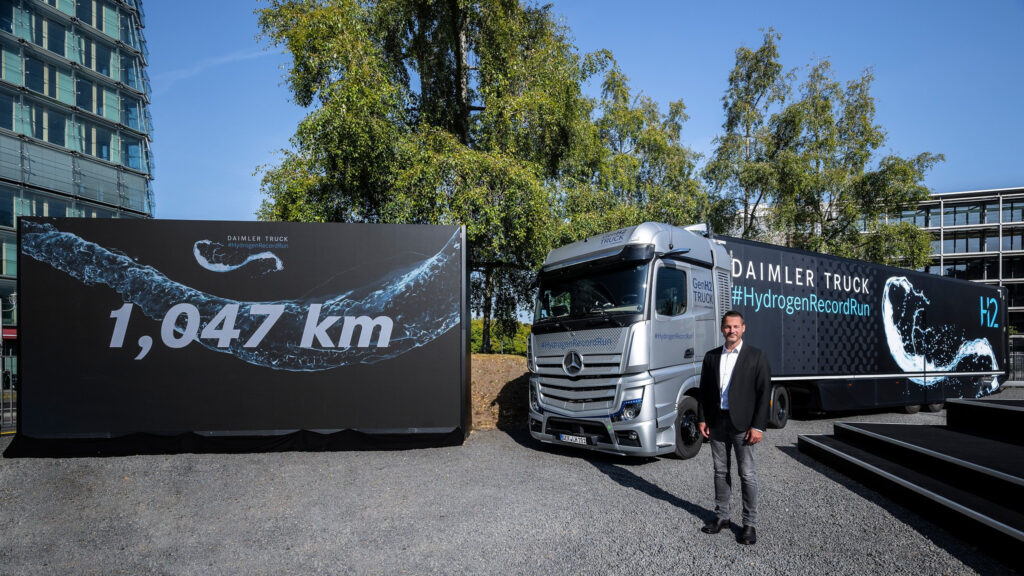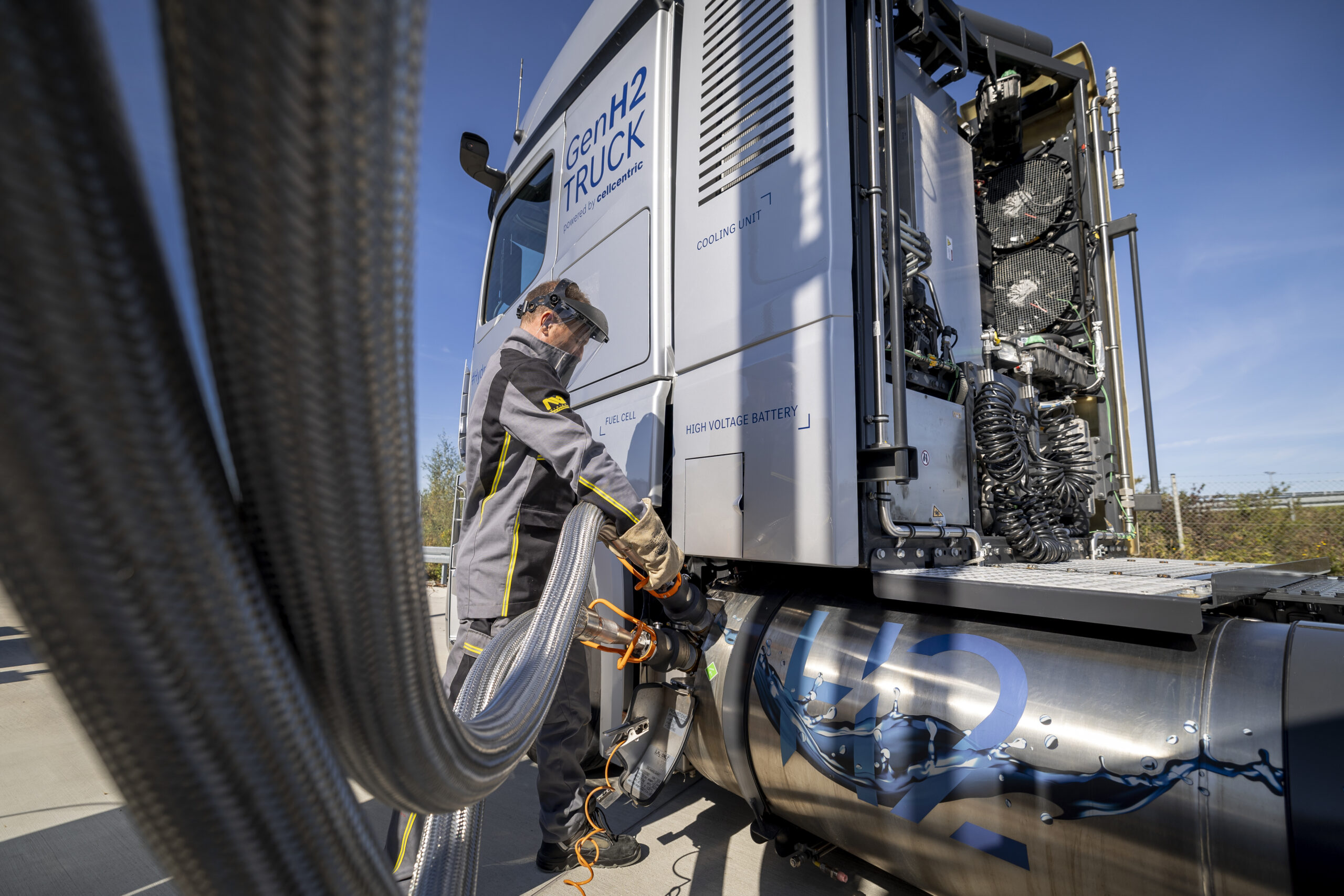Mercedes-Benz pushes the range envelope with hydrogen and electric trucks
- PostedPublished 16 December 2023
Mercedes-Benz has been making headlines recently. First, its GenH2 prototype – approved for public road use – completed the #HydrogenRecordRun, where it covered 1047km using just one fill of liquid hydrogen. Soon after, an eActros 600 prototype took the spotlight, travelling over 1000km with only a single intermediate charge.

Daimler has since confirmed that the GenH2 hydrogen truck is scheduled for production between 2025 and 2030. However, the battery electric eActros 600 is expected to be released sooner, potentially leading to rivalry between the two models.
Battery electric trucks are often preferred for distribution and long-distance haulage when the routes are predictable and charging options are available. Hydrogen-based drivelines could be a better choice for demanding and flexible operations in heavy-duty transport and long-distance haulage.
With a gross weight of up to 44 tonnes, the eActros can transport 22 tonnes of goods around 530km on a single charge
The GenH2
On September 25, 2023, at Mercedes parent company Daimler Trucks’ testing centre in Wörth, Germany, the fully laden GenH2 truck had its two 40kg stainless steel tanks filled with cryogenic liquid hydrogen chilled to -253˚C. This hydrogen supply, courtesy of Air Liquide, was produced using biomethane derived from organic waste materials.
The hydrogen tanks of the GenH2 truck feature a special double-tube design, with one tube nestled inside the other. These tubes are connected and vacuum-insulated, effectively maintaining the hydrogen at the necessary temperature without the need for active cooling. Once filled, both tanks were officially sealed by TÜV Rheinland in preparation for the #HydrogenRecordRun to Berlin.
Daimler uses liquid hydrogen for hydrogen drivetrains due to its significantly higher energy density compared to gaseous hydrogen. This enables a larger amount of hydrogen to be stored in a smaller space, resulting in an extended range for the vehicle. Moreover, the use of liquid hydrogen allows the vehicle to achieve a performance level comparable to that of a conventional diesel truck.

Liquid hydrogen has both advantages and disadvantages, not least the fact it is not currently available anywhere in Germany. The truck plant in Wörth, where Daimler manufactures many of its vehicles, only has a temporary hydrogen filling station, although a permanent site will open soon. The lack of infrastructure for this energy source meant that the GenH2 truck had to be loaded onto a semi-trailer for its return trip to Wörth after its remarkable 1047km #HydrogenRecordRun to the capital.
“Our record run today is a reminder that decarbonising transportation requires two other factors in addition to the right drive technologies: a green energy infrastructure and competitive costs compared to conventional vehicles,” said Daimler Truck head of truck technology Andreas Gorbach.
“The world needs hydrogen … If zero-emission trucks were powered exclusively by batteries in the future, every highway service area would have to have somewhere between 20 and 50 charging stations. In other words, each rest stop would have the energy requirements of a small town.”
Based on the Mercedes Actros, the pre-series GenH2 is equipped with twin electric motors, providing a continuous power output of 460kW and temporary peaks of up to 660kW. Its hydrogen fuel-cell system supplies 300kW of power, with an additional temporary boost of 400kW from the 70kWh battery, which is used for power support during peak loads; this can be recharged using regenerative braking and excess fuel-cell energy. With a gross weight of 40 tonnes and a payload capacity of 25 tonnes, it offers diesel-competitive hauling.
The eActros 600

On October 10, 2023, after extensive testing, Daimler Trucks launched the all-electric eActros 600, with first deliveries due by the end of 2024. Notably, by that time, other major truck manufacturers like Renault Trucks, Scania, and Volvo will also have electric models available.
With a gross weight of up to 44 tonnes, the eActros can transport 22 tonnes of goods around 530km on a single charge. Mercedes contends that since 60 per cent of long-distance trips are under 500km, depot charging will be adequate for most. Nonetheless, as proven, the eActros is also capable of over 1000km in a day once you allow for intermediate charging during legally mandated driver breaks. This impressive range positions the eActros as a strong competitor to both the short-range version of the Tesla Semi and the Nikola Tre BEV.
The electric architecture of the eActros 600 is based on an 800-volt system. It features a twin-motor drivetrain, delivering a continuous performance of 400kW, which can be boosted to 600kW, and is delivered via a specifically developed long-haul four-speed transmission.

Three lithium-iron phosphate (LFP) battery packs – which Daimler claims are durable enough to retain 80 per cent of their capacity after 10 years or 1.2 million km – can store 621kWh of energy that can be partially recouped during deceleration.
From launch, the eActros 600 can be charged through its CCS2 connector at rates up to 400kW. It will also be capable of accepting up to 1MW of DC power, and once megawatt charging becomes standardised in 2024, it will allow the LFP batteries to be charged from 20-80 per cent in about 30 minutes.
Daimler claims that even though the eActros 600’s purchase price will be 2.5 times higher than its diesel equivalent, the savings on electricity compared to fuel costs, along with government support, would make the investment profitable after five years of driving.
“This makes entry into e-mobility even more attractive for fleet operators,” said Mercedes-Benz Trucks CEO Karin Rådström. “The eActros 600 stands for the transformation of road freight transport towards CO2-neutrality like no other truck with a three-pointed star.”
A fleet consisting of approximately 50 prototype vehicles is currently being built by the company to undergo testing with customers. Additionally, Daimler Trucks mentioned that they would offer financial assistance to smaller clients to help facilitate the transition to electric vehicles.
The end of the diesel Actros?
“How quickly battery and hydrogen will replace the diesel engine also depends on how resolutely regulators support the operation of zero-emission vehicles and make the use of diesel more expensive,” said Freightliner CEO Martin Daum at the Daimler Truck Holding AGM.
“To decarbonise transport, we need both battery-electric and hydrogen-powered drive technologies,” added Mr Gorbach.
“With hydrogen, we are a few years behind the battery on the timeline – and that is exactly the right roadmap. Because a refuelling infrastructure for hydrogen will not realistically be in place for several years – that is, when we put our vehicles on the road,” said Mr Daum.
“So far, we have focused primarily on fuel cells. But, of course, we are also keeping a very close eye on the discussion about a hydrogen combustion engine … It is also difficult to predict how the exact mix of battery and hydrogen will develop. The challenging development of a Europe-wide charging infrastructure plays an important role here, as do future energy prices.”
- CategoriesIn SightGlass
- Tagselectric truck, electric vehicles, EV, Hydrogen, hydrogen fuel cell, hydrogen trucks, SightGlass News Issue 31, trucks


